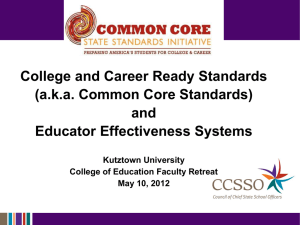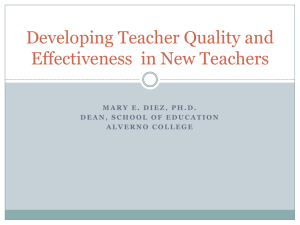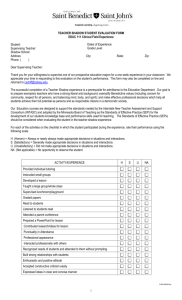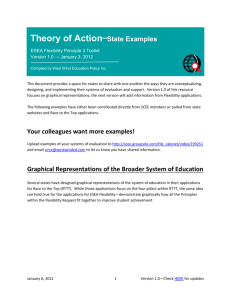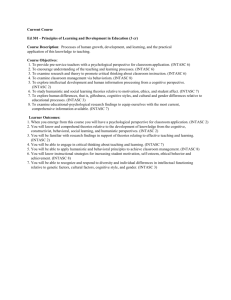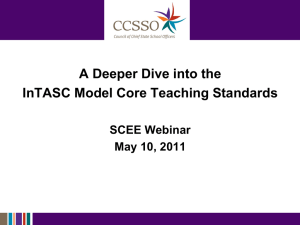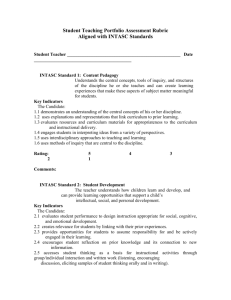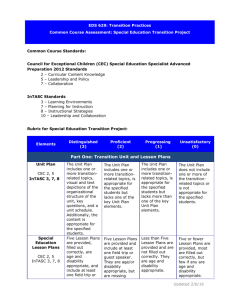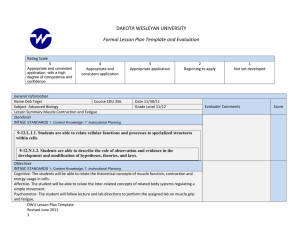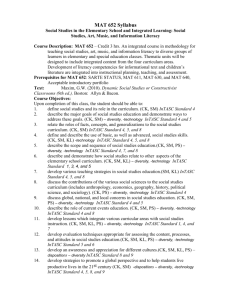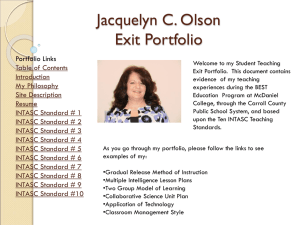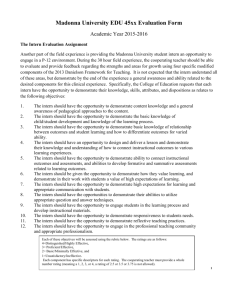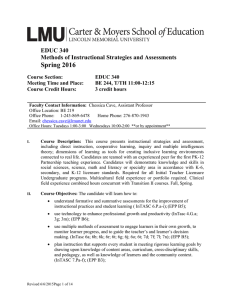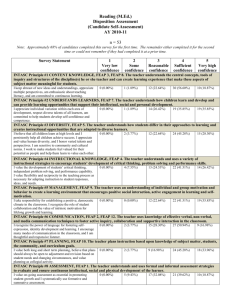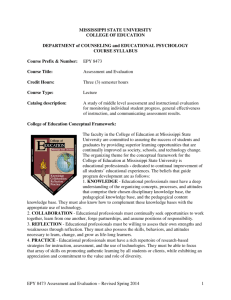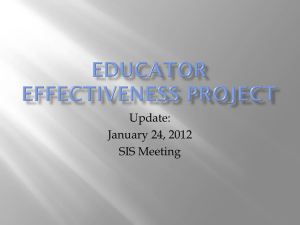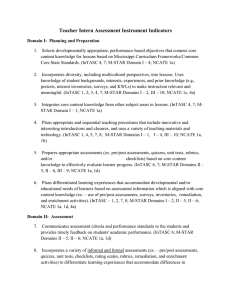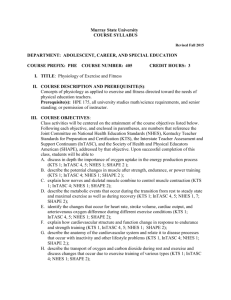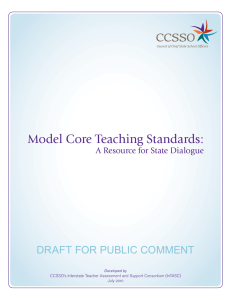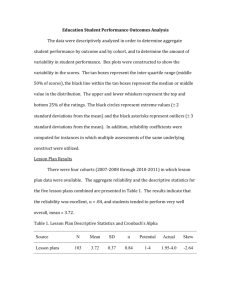NCSA Presentation 2011
advertisement
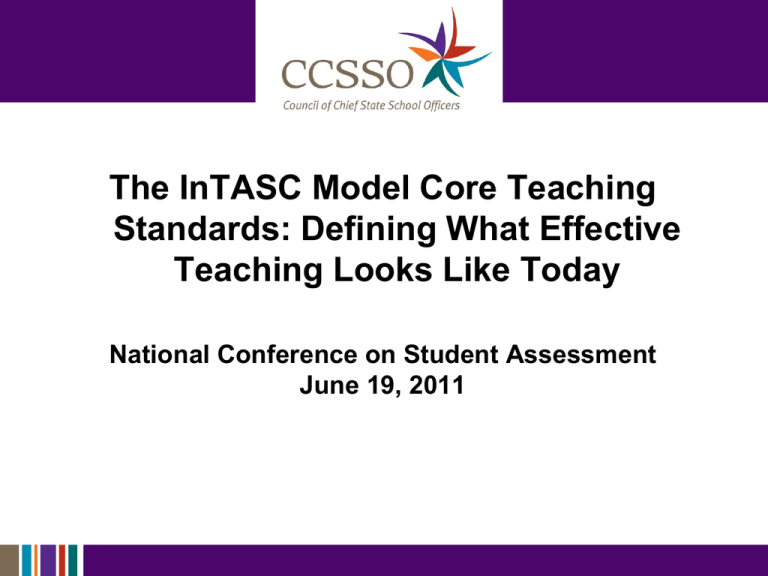
The InTASC Model Core Teaching Standards: Defining What Effective Teaching Looks Like Today National Conference on Student Assessment June 19, 2011 Presenters Kathleen Paliokas Director, Interstate Teacher Assessment and Support Consortium (InTASC) Carlene Kirkpatrick Instructional Coach, DeKalb County Schools, Georgia National Board Certified Teacher (EA Mathematics) Served on the InTASC Model Core Standards Update Committee Student Success High Quality Instruction & Leadership Core Teaching Standards Growth Opportunities & Supports Educator & System Accountability Professional Development Standards Data Standards Common Core State Standards for Students School Leader Standards InTASC Model Core Teaching Standards Update Process Original standards released in 1992 Revision conducted by expert panel that included: Practicing teachers Higher education faculty who prepare educators State education agency staff Funding contributed by Educational Testing Service (ETS), Evaluation Systems of Pearson, National Education Association (NEA) A companion policy document was released with the standards Key Changes from the 1992 Standards Developmental Continuum: Standards no longer just for beginning teachers but ALL teachers. INTASC becomes InTASC (Interstate Teacher Assessment and Support) A Focus on 21st Century Knowledge and Skills: Problem solving, curiosity, creativity, innovation, communication, interpersonal skills, the ability to synthesize across disciplines, global literacy, ethics, and technological expertise. Personalized Learning for Diverse Learners: Teachers need knowledge and skills to customize learning for learners with a range of individual differences. Key Changes to Standards (continued) Increased Emphasis on Assessment Literacy: Teachers need to have greater knowledge and skill around how to develop a range of assessments and how to use assessment data to improve instruction and support learner success. A Collaborative Professional Culture: Teaching is not a private act. New Leadership Roles for Teachers and Administrators: A shift in leadership from teachers working autonomously in their classrooms to administrators, teachers, and others sharing leadership roles and responsibilities for student learning. Groupings of Standards The Learner and Learning Standard #1: Learner Development Standard #2: Learning Differences Standard #3: Learning Environments Content Standard #4: Content Knowledge Standard #5: Application of Content Groupings of Standards Instructional Practice Standard #6: Assessment Standard #7: Planning for Instruction Standard #8: Instructional Strategies Professional Responsibility Standard #9: Professional Learning and Ethical Practice Standard #10: Leadership and Collaboration Key Cross-Cutting Themes in Updated InTASC Standards Theme Knowledge Disposition Performance *Collaboration 3(g), 3(h), 3(i), 5(p), 10(f), 1(k), 3(k), 3(l), 3(nm), 1(c), 3(a), 3(b), 3(d), 5(f), 6(b), 10(h) 5(v), 6(m), 7(l), 8(s), 9(l), 10(k), 10(l) 3(i), 3(j), 5(o), 6(j), 8(o) 3(o), 3(n), 6(o), 8(u) *Communication *Creativity/innovation *Critical thinking, problem solving Cultural competence 7(a), 8(b), 8(c), 9(a-c), 9(e), 10(a), 10(b), 10(c), 10(d) 3(b), 3(e), 5(e), 5(f), 6(c), 8(h), 8(i), 8(j), 10(e) 5(k), 5(q), 8(l), 8(o) 3(m), 5(v) 5(d), 5(g), 5(h), 6(g), 8(k), 9(f) 4(h), 5(j), 5(n), 6(k), 8(l), 8(n) 4(n), 5(s), 8(r) 4(b), 4(c), 5(a), 5(b), 5(d), 5(g), 5(h), 6(d), 8(f), 8(g), 8(k), 9(b) 1(g), 2(i), 2(l), 2(m), 3(i), 4(k), 5(r), 7(f), 8(m) 3(n), 4(m), 5(v), 5(w), 7(f), 8(t), 2(f), 3(e), 5(h), 9(c) InTASC Teaching Standards Linked to Common Core Students Standards CCSS Mathematics InTASC Teaching Standards Standard 5: Dissemination and Public Comment Feedback Broad outreach – press release, e-mail blasts, online survey, focus groups, blogs, twitter, briefing of executive directors of national associations Public comment ended early November 2010 Raw numbers 104 online surveys completed (+400 partials) – 36 states 325 people participated in 23 focus groups Numerous ad hoc email messages and formal letters Synthesis and analysis completed and changes incorporated Public Comment Feedback Critical General Comments • Standards too broad to be useful • Redundant and wordy, too many indicators • Need to give more weight to accountability and outcomes • This is status quo – would have been cutting edge a decade ago • Teacher leadership needs to be more explicit – it is more than collaboration • Lack of specific reference to students with disabilities is a weakness Changes to Public Comment Draft Strengthened teacher leadership expectations • #10 renamed to Leadership and Collaboration Strengthened ongoing learning of teachers • #9 renamed to Professional Learning and Ethical Practice Strengthened assessment literacy further • Called out formative and summative • Added learner capacity to evaluate his/her own progress Changes to Public Comment Draft Added explicit language tied to Common Core Learning progressions, sequencing, stronger accountability language for outcomes Added teacher will assure “mastery of content” to stem of #4, added “performance against standards” in indicators of #4 Clarified accommodation and differentiation language Added a glossary of key terms Next Steps Work with states to move the standards into policy and practice Identify with states key tools and resources to be developed Developmental continuum aligned to the standards Model rubric and indicators aligned to the standards Comprehensive website with video clips aligned to the standards Meet with partners around the companion paper, Implications of the Model Core Teaching Standards for State Policy Policy Implications Taking the standards to the next level of grain size – what does that look like? Developmental Continuum Assessment at key transition points • End of Pre-service – TPAC as one example • NBPTS – accomplished teaching • What does tier 2 or professional license assessment look like? Policy Implications Reform in Preparation Program approval/accreditation as leverage Clinical practice Ongoing Professional Learning New collaborative culture and use of data Teacher Evaluation Defining “effectiveness” Student growth and multiple measures State Consortium on Educator Effectiveness (SCEE) CCSSO is well situated to lead systemic approach Goal is implementation of standards-driven coherent systems of educator effectiveness Three areas of focus Standards for Learning, Teaching and Leading Professional Growth and Support for Teaching and Leading Evaluating Teaching and Leading Incorporates InTASC and SCEL within a larger umbrella 28 states have joined SCEE and named 6-member teams SCEE provides states with a forum for sharing via Monthly webinars Collaborative work site National summit Regional/topical meetings SCEE Summit 1st SCEE National Summit on Educator Effectiveness was held April 28-30 in Washington DC 6 breakout strands – – – – – – Preparation Tiered licensure Teacher evaluation Leader evaluation Professional development Systems change Note: The June 14 SCEE webinar will provide a summary of the breakout strand discussions (www.ccsso.org/scee) SCEE Summit Feedback Regarding each strand, states would like To know what other states are doing Models, tools, lessons learned To know how to integrate “effectiveness” (e.g., student growth) into all aspects of the system To know what the research tells us about the impact of different strategies For More Information Please go to: www.ccsso.org/intasc • • • • Free PDF of standards Bound copies can be ordered from Amazon Free PDF of State Policy Implications paper Research base is available Contact Information Kathleen Paliokas kathyp@ccsso.org 202-336-7058 Carlene Kirkpatrick Carlene_L_kirkpatrick@fc.dekalb.k12.ga.us
